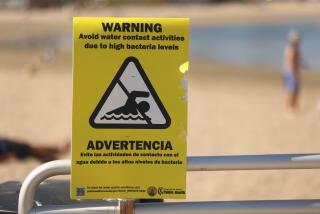Stay out of the water? No way
In Southern California, surfing can be a contact sport.
Paddle out of almost any beach and thereâs a chance youâll come in contact with a sewage spill, big-city runoff, a red tide or, sometimes, floating cattle.
The 2-million-gallon sewage spill that closed an 11-mile stretch of South Bay beaches earlier this month was the latest blow to the local surfing scene. The seepage came a few months after the environmental group Heal the Bay reported that L.A. County beaches last summer had the worst water quality in five years. The main ingredient of the pollution: fecal bacteria.
But some surfers canât keep their feet on dry land when great waves kick up. To the more common surfing perils of wipeouts and face plants, they add the risk of liver damage, diarrhea and eye infections.
This roll-the-dice attitude was evident on a recent Friday at Manhattan Beach before lifeguards reopened the shores. Half a dozen surfers had ignored closure signs and jumped into the surf not far from several bulldozers that were burying tons of contaminated sand.
âI think Iâll live,â Don Benson, a 56-year-old fitness trainer, said after climbing out of the surf, his wet suit glistening with salt water. He had been surfing just outside the spill zone for three days and had felt no ill effects. So on that day, he decided to chance it. After all, the water was a tempting 54 degrees, the waves crested at about five feet and the sky was a flawless blue. âWeâll see what happens tomorrow. But I think Iâll be OK,â he said.
Besides, he pointed out, although he has surfed nearly his entire life, his only affliction came when he got a staph infection after surfing with an open cut -- in Hawaii.
Even those surfers who monitor water test results conducted by public health officials and avoid closed beaches can be caught off guard by a spill, surfer Balin Hewitt pointed out while changing out of his wet suit recently at Will Rogers State Beach, about 10 miles north of the Manhattan Beach spill site.
âYour eyes will burn, and the water smells like diesel fuel,â the Santa Monica film production supervisor said of his past run-ins with polluted surf. The result, he said, feels like 24-hour flu, including nausea and diarrhea.
Contact with contaminated water can lead to a variety of nasty waterborne ailments. Ear, nose and eye infections are the most common illnesses, health officials say, as are skin rashes. Gastroenteritis (which can cause several days of vomiting and diarrhea) and staph infections that only antibiotics can clear up are also possible.
Huntington Beach surfing legend Timmy Turner recently survived two brain surgeries to treat complications from a severe staph infection caused by an infected surfing wound.
A less frequent but also potentially serious illness caused by exposure to contaminated ocean water is hepatitis A, an inflammation of the liver. The condition, which requires rest and hydration, has no quick drug treatment.
Public health officials donât keep track of the number of Southern Californians who become ill from swimming or surfing in the ocean. But lifeguards suspect that number is on the rise based on the legions of surfers they see ignoring beach closure signs and venturing into the waves shortly after a rainstorm. Health experts suggest surfers stay out of the water for 72 hours after a rain to avoid the trash, oil and other muck that rainwater carries into the sea.
Viruses and bacteria in the water attack surfers and other beachgoers by entering through the mouth, ears, eyes and open wounds, said Dr. Eric Savitsky, a longtime surfer and a UCLA associate professor of emergency medicine. Wet suits donât protect against skin rashes because the suits are designed to keep a warm layer of water between the skin and the suit. Some surfers try to cut their risks by wearing earplugs or shutting their eyes and mouths while ducking under waves, but Savitsky says such precautions are virtually useless.
The best way to avoid waterborne illnesses is to stay out of the surf after a sewage spill or a downpour and rinse off with fresh water after each venture into the ocean, he said.
âI think the lure of good surf weighs heavily on the minds of the surfers,â said Mike Silvestri, a lifeguard supervisor at San Diegoâs Carlsbad beach who is well accustomed to surfersâ indifference toward health warnings.
âWe try to do the best we can to explain that weâve had lifeguards get sick from going out on rescues,â he said.
At Manhattan Beach, a thirtysomething surfer in a full-length wet suit pulled his board from the water and sauntered past a bright yellow sign in the sand warning âKeep Out. Sewage contaminated water.â Although the conditions were great for surfing, a whiff of sewage drifted through the air.
The die-hard surfer, who identified himself only as Blake, said he has been surfing South Bay beaches for 15 years and has never been ill from water contamination. Maybe heâs built up an immunity to it, he said. âI figure Iâm in it every day, so itâs all good,â he said before rinsing off at a nearby public bathroom.
Up the coast about 10 miles away, Michael Sweeney, an electrician from Carpinteria, was squeezing out of his wet suit after surfing at Will Rogers State Beach. He says he looks for beach closure signs but usually lets his nose be his guide on hazardous surf conditions.
âIf it totally doesnât pass the smell test, no matter what, you just donât go out,â he said.
But Sweeneyâs technique has not always served him well. He recalled surfing several years ago off San Diego Countyâs Imperial Beach, after a sewage spill in Tijuana, when a dead cow floated by his surfboard.
âThat is when I said, âIâm outta here!â â Sweeney said.



